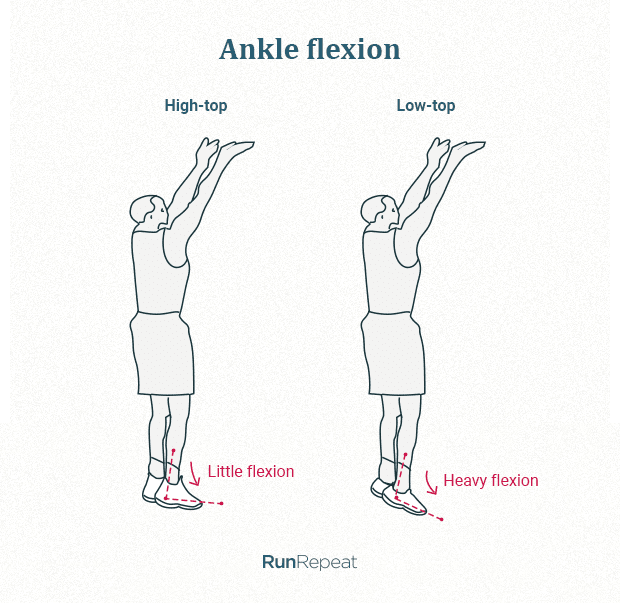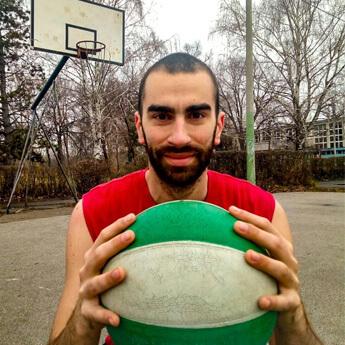High-top vs. Low-top Basketball Shoes
After spending over 100 hours summarizing 30 scientific studies and analyzing over 450 models from RunRepeat’s shoe database, we’re delivering an ultimate guide that will answer all of your questions on high-top and low-top basketball shoes.
For almost half a century, high-top shoes were a synonym for basketball footwear. As foot and ankle injuries are the most common injuries in basketball (source), it seemed logical that the high-tops provide better ankle support and overall safety of the player’s feet.
In 2008, Kobe Bryant became the first basketball superstar with a low-top signature shoe (Nike Kobe IV) and won NBA Championship along with Finals MVP that season. It paved a way for the emergence of low-tops in the NBA. Today, players like James Harden or Steph Curry regularly utilize low-top to accommodate their game.
Still, the question remains - why choose one over the other? Does collar height affect the on-court performance? Are your ankles more protected in high-tops? Are you quicker and more agile in low-tops?
This guide will break these questions down for you.
High-top vs. low-top shoes breakdown
We analyzed 31 academic studies that compare high-top and low-top basketball shoes, covering both athletic performance and foot/ankle health aspects.
We’ll break down the most important terms we’ll be dealing with when comparing the effects of high and low-tops. In summary, we’ll be talking about:
| Aspect | High-top vs. Low-Top shoes | |
|
Athletic performance
|
There was no relevant scientific study that shows there is a difference in athletic performance between players wearing the high-top and low-top shoes | |
|
Ankle sprains |
|
|
|
Ankle movement
|
Depending on the testing conditions, differences in ankle inversion angle between high-tops and low-tops are either insignificant or larger in the low-top shoes (up to 5 degrees). The minimal dorsiflexion angle between ground and feet is smaller in low-tops (77.0 degrees in lows, 85.1 in highs). These findings show that wearing low-tops can provide more freedom of ankle movement, which fits players who employ a lot of sudden shifts in movement. |
|
|
Muscle activation
|
Several studies showed that the pre-activation of muscles has a higher intensity when the subjects were wearing low-top shoes. Also, the onset time (time from the moment the inversion starts to the moment when the body reacts to inversion) was significantly higher in high-top shoes. These findings suggest that in certain conditions, high-top shoes prepare the foot for the inversion more quickly and require less muscular effort than low-tops, which benefits players who rebound the ball a lot. |
|
1. Shoe top and athletic performance
When a basketball player is choosing the footwear for the game, 2 main questions emerge - “Will these shoes protect my feet better?” and “How will they affect my performance?”.
The most important performance aspects for basketball players are speed/quickness (frontal and lateral) and jumping ability. From the reviewed studies, there are 0 (zero) that suggest that shoe top height affects athletic performance to any significant extent. To name a few:
- “Shoe collar height did not affect sagittal plane ankle kinematics and had no effect on performance during realistic jumping.” - Yang Yang, 2017
- “No shoe differences were found for performance variables (sidestep cutting, jumping and agility tasks)... both collar height and counter-stiffness have no effect on athletic performance.” - Hui Liu, 2017
- “Across all performance tests (60-yd sprint, cutting drill, agility ladder), no significant difference was found between any of the shoes (high-tops, mid-tops, low-tops).” - Calvin W. Daack, 2014
If you look at the best basketball players, you can’t create any kind of correlation between the collar height of their shoes and their on-court performance. Kobe Bryant was as good a basketball player with high-tops as he was with the low-top models.
Regardless of the top height, a proper locked-in fit of a shoe will affect both performance and overall safety of your feet. This is why choosing the perfect size and lacing the shoes properly is extremely important. Our size and lacing guides will help you with that.
2. High-tops vs. low-tops and ankle sprains
One of the reasons why high-tops were dominant basketball shoes for almost half a decade was the reasoning that they provide better ankle support than low-tops. But is that a case?
When the ankle ligaments get stretched beyond their normal range, an ankle sprain occurs. In basketball, ankle sprains mostly occur during landing after taking a shot (jump shot, layup, dunk) or grabbing a rebound, after the player's feet land on an uneven surface. Usually, that uneven surface is another player’s feet. The most common type of ankle sprain is a combination of both ankle inversion and flexion.
Inversion and eversion are rotations of the ankle towards the middle and the side, respectively. They naturally occur during lateral movements in basketball, such as cutting action with or without the ball, along with any kind of crossover dribble.
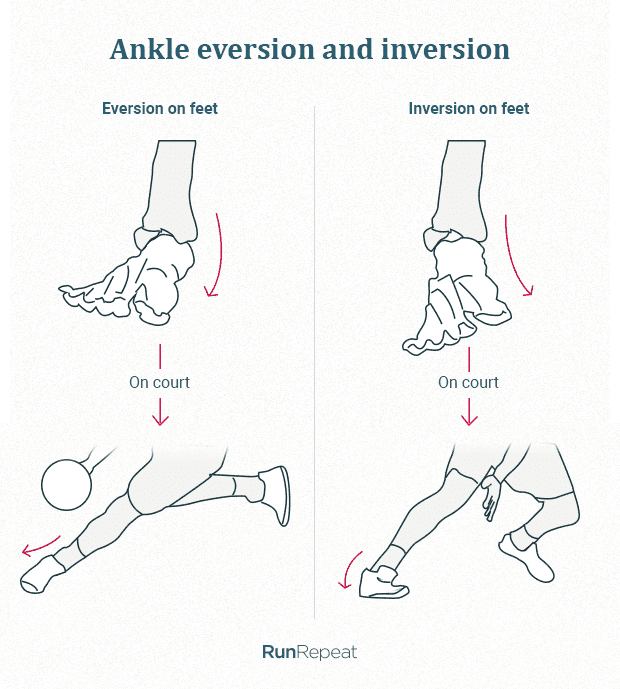
When the rotation of the ankle occurs around the sagittal plane, it’s called plantar flexion (rotation downwards) and dorsiflexion (rotation upwards).
Ankle flexion is one of the most common body movements in basketball. The most obvious example would be a jump shot or a layup/slam dunk.
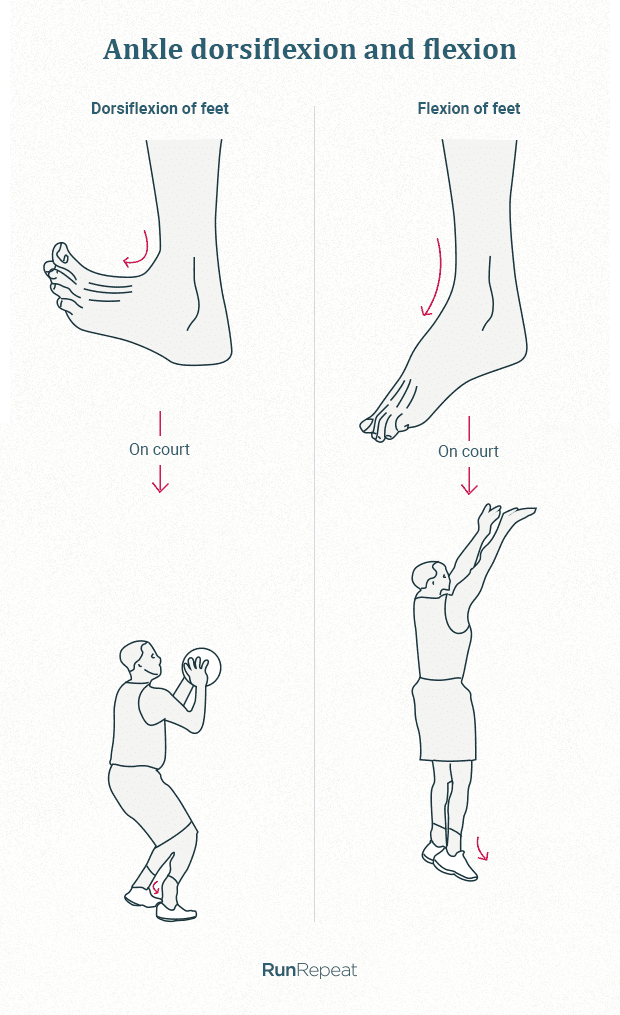
Several studies were designed to establish the effect of the collar height on ankle sprains. Only one concludes that wearing high-top shoes led to a reduction in the number of ankle sprains (Garrick and Requa, 1973). However, the study was conducted in 1973, and the design of both high and low-tops significantly changed since. No other study finds a difference in ankle injuries between highs and lows.
To an even greater surprise, ankle sprains, as severe as they are, happen both in lows and highs so often that the NBA, that the league changed its rules in order to sanction actions that lead to this kind of injuries (Zaza Rule).
3. Ankle movement in high-tops vs. low-tops
Studies in which the subjects landed on inverted platforms (simulation of landing after layup or jump-shot), found no significant differences in the inversion angles between high-tops and low-tops.
However, when the test subjects were placed on a flat platform that induced sudden inversion, significant differences in inversion angles were observed.
Most noticeably, low-tops allowed 4.5 degrees larger ankle inversion than high-tops: 38.1 degrees in high-tops and 42.6 in low-tops (Richard and Saret, 2000). This motion relates to player cutting maneuvers such as crossover or an off-ball cutting.
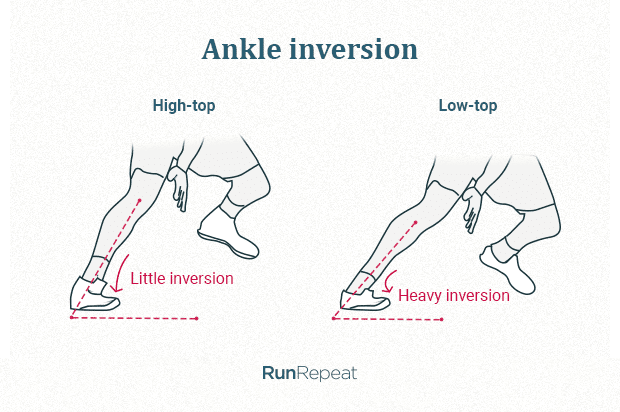
These findings show that wearing low-tops can give your ankle some slight edge in freedom of movement. This is the reason why low-tops are very popular among players who deploy a lot of sudden cutting movements in their game, most notably James Harden.
In terms of flexion, Yang and Fang (2017) showed that the subjects with low-tops had a significantly larger range of motion (32.2 degrees compared to 27.0) than high-tops during weight-bearing dorsiflexion maneuvers (squats). Also, the minimal angle between ground and feet was smaller with low-tops (77.0 degrees in lows, 85.1 in highs).
4. Muscle activation in high-top vs. low-top shoes
Similar to ankle movement, depending on the conditions, collar height can affect the activation of leg muscles (tibialis anterior, peroneus longus, and peroneus brevis) during ankle inversion. Several studies showed that the pre-activation of muscles has a higher intensity when the subjects were wearing low-top shoes.
Also, the onset time (time from the moment the inversion starts to the moment when the body reacts to inversion) was significantly lower in low-top shoes.
These findings could suggest that high-top shoes require smaller muscular effort and the body’s proprioceptive feedback during landing. This is the reason why a lot of big-men in basketball prefer high-tops, as they have to deal with a lot of rebounding under the rim.
RunRepeat data
We analyzed 450 basketball shoes in RunRepeat’s database to compare both user and expert experiences with high-tops and low-tops.
There are 60% more low-cut models compared to high-cut in our database, and they are more popular at the moment (RR popularity score for low-tops is 86.7 compared to 68.4 for high). This was unimaginable just 2 decades ago, but low-tops are no longer in the shadow of their higher counterparts.
In terms of ratings, low-tops have a slight edge with the experts (average shoe rating by the expert reviewers), while high-tops prevail with the users (average shoe rating by users).
| Aspect | High-top shoes | Low-top shoes |
|
Models |
94 | 151 |
|
Popularity |
68.4 | 86.7 |
| Expert score | 65.5 |
68.1 |
| User score |
88.2 |
87.9 |
| Overall score |
87.1 |
86.7 |
We also looked into the “price per gram of material” aspect of collar heights. We looked into 27 models that come in both high and low-tops versions.
On average, high-tops are 60 grams heavier than low-tops.
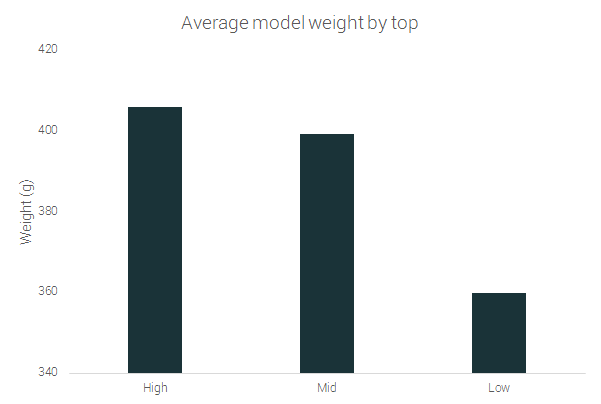
Looking at “price per gram of material”, low-tops are 1 cent cheaper per gram of material. Mid-tops dominate this segment:
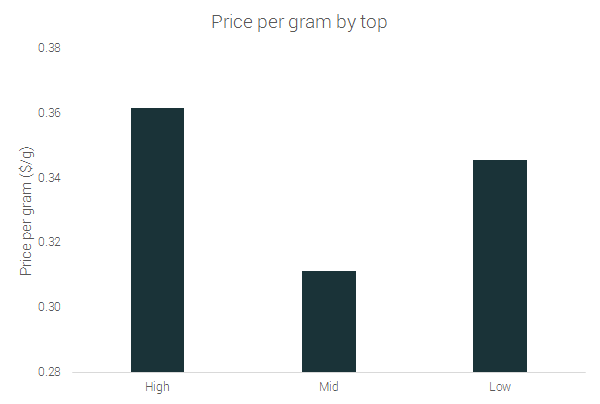
Conclusion
In certain conditions, low-top shoes proved to provide larger freedom of ankle movement, which benefits players whose game is built upon a lot of quick changes of direction. Also, high-tops proved to require less muscular effort during muscle activation, which is beneficial for players in charge of rebounding the basketball.
However, there’s not a single scientific evidence that proved that collar height has any kind of effect on both athletic performance and ankle/foot safety.
Therefore, we advise you to choose the ones that make you the most comfortable on the basketball court and to lace them up properly. The overall sense of stability and comfort are more important factors than the height of a shoe collar.
